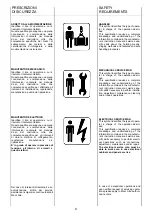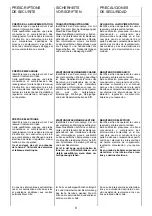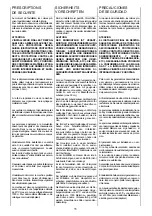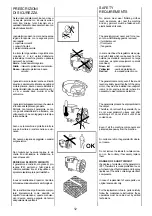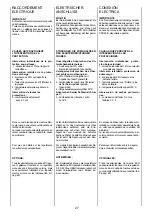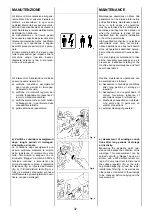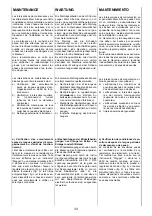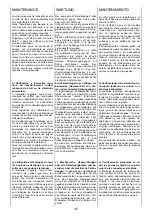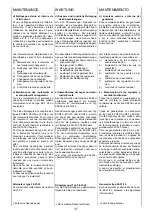
ACCOPPIAMENTO
ELETTRICO
L’accoppiamento elettrico e’ a cura dell’utiliz-
zatore finale ed e’ eseguito secondo la sua
sola discrezione.
Per l’ingresso nella scatola morsetti si racco-
manda di utilizzare passacavi e serracavi in
accordo con le specifiche del paese di espor-
tazione.
COLLEGAMENTO AVVOLGIMENTI
Sono previsti entrambi i collegamenti, stella
con neutro ( Y ) e triangolo (
∆
) in tutti gli
alternatori (tav. 2 pag. 58).
Per passare da un collegamento Y a
∆
(es.
da 400V a 230V) e’ sufficiente spostare i
ponti sulla morsettiera principale (vedere
schema tav. 2 pag. 58).
Nessun intervento e’ richiesto sul regolatore
di tensione.
I generatori sono costruiti di serie con 12
cavi di uscita per consentire di ottenere ten-
sioni diverse (es.230 / 400 / 460 / 800V).
I generatori, vanno sempre collegati a terra
con un conduttore di adeguata sezione utiliz-
zando uno dei due (interno/esterno) appositi
morsetti.
Dopo aver eseguito il collegamento (per le
coppie di serraggio vedere tabella 19
pag.67) rimontare il coperchio scatola mor-
setti.
IMPORTANTE
: variazioni di frequenza.
La macchina fornita per funzionare a 50Hz
puo’ funzionare anche a 60Hz (o viceversa);
e’ sufficiente tarare il potenziometro al nuovo
valore nominale di tensione.
Passando da 50Hz a 60Hz, la potenza puo’
aumentare del 20% (corrente invariata), se
la tensione aumenta del 20%; se la tensione
rimane invariata la potenza, puo’ aumentare
del 5% per effetto della migliore ventilazione.
Per generatori costruiti appositamente per
una frequenza di 60Hz nel passaggio a
50Hz, la tensione e la potenza devono ne-
cessariamente diminuire del 20% rispetto a
quella riferita a 60Hz.
REGOLATORI
(tav. 3 pag 58)
I regolatori tipo U.V.R.6/1-F e S.R.7/2-G
possono essere indifferentemente usati nella
serie ECO senza modificare le prestazioni.
L’U.V.R.6/1-F e’ montato di serie nelle tipolo-
gie 34 - 38 - 40 - 43 - 46, mentre l’S.R.7/2-G
nelle serie 28 - 31 - 32.
I due regolatori sono perfettamente uguali
nelle prestazioni, ma si differenziano nelle
segnalazioni e nel riferimento.
22
ELECTRICAL
CONNECTIONS
All electrical output connections are the re-
sponsibility of, and are at the discretion of,
the end user.
When making terminal box connections, all
cable and terminal lugs should meet the
relevant standards of the country of final
destination.
WINDINGS CONNECTION
All alternators feature both star with neutral
(Y) and delta (
∆
) connections (table. 2
pag.58) .
To reconnect from a star to delta connection
(for ex. from 400V to 230V), modify the
linking arrangements on the output terminal
board (see diagram on table 2 page 58).
It is not necessary to adjust the voltage regu-
lator.
Standard alternators are equipped with 12
cables to offer different voltages (ex.230 /
400 / 460 / 800V).
The alternator must always be earthed by
sufficiently rated cable, using one of the in-
side or outside terminals.
After completing output connections (for ti-
ghtening torque see tab. 19 pag. 67), en-
sure that the terminal box cover is securely in
place.
IMPORTANT
: frequency variations.
A standard production machine wound for
50 Hz can also function at 60 Hz (and vice
versa) by resetting the A.V.R. voltage poten-
tiometer to the new nominal voltage value.
When changing from 50 to 60 Hz the alter-
nator power, and nominal voltage will incre-
ase by 20%, but the current does not change
from 50 Hz value. Should voltage stay at 50
Hz nominal value, then the output power
may be increased by 5% due to improved
ventilation.
For machines wound for 60 Hz, changing to
50 Hz, the voltage and power values have to
decrease by 20% of 60 Hz value.
REGULATORS
(table. 3 pag 58)
Either U.V.R.6/1-F and S.R.7/2-G regulators
can be used on the ECO series without
affecting performances.
The U.V.R.6/1-F is a standard feature on the
34-38-40-43-46 models whereas the
S.R.7/2-G is standard on the 28-31-32 se-
ries.
The two regulators ensure the same level of
performance but have different signal sy-
stems and references.
PERICOLO
DANGER
GEFAHR
PELIGRO

